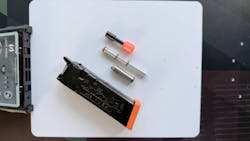CQB in a Box: Laser Ammo's Portable Dry Fire System Delivers Realistic Scenario Training
I got a chance to test Laser Ammo’s CQB in a Box, a dry fire system that is so portable, the kit, including the targets, fit into a duffle bag. There are many dry fire systems on the market right now, but not all of them deliver realistic scenario training. The CQB in a Box does.
CQB in a Box consists of 3 targets, each with 3 reactive hit zones, a wireless controller, and the carrying bag. It is designed to be used with Ammo’s SureStrike Cartridge, which emits a laser pulse when fired. This cartridge can be purchased in a SureStrikeMAG kit, which has the magazine and cartridge.
CQB in a Box uses Laser Ammo’s SureStrikeMAG, which is a magazine system that allows dry fire without a manual trigger reset. I got the Glock kit, which looks similar to the real Glock Magazine, except it has a protrusion near the feed lips that engage the trigger mechanism of my Glock. When combined with the SureStrike Cartridge, the system simulates trigger pull, and fires a laser pulse out the barrel. The SureStrikeMAG wirelessly connects with the SureStrike Cartridge, simulating the trigger pull without actually using my Glock’s striker. The trigger feel is genuine, and proved to be consistent. With every pull of the trigger, the SureStrike Cartridge fires the laser. The system gives audible and tactile trigger simulation.
If I just used the SureStrikeMAG, I would have a great dry fire system. The standard trigger weight this system delivers is 5.5 lbs. It comes with a lighter spring, which takes about 5 seconds to swap. There are heavier springs available, for those who really need trigger finger exercise.
The SureStrike Cartridge consists of tube-shaped cylinder that fits into the gun’s chamber like a cartridge. It has an emitter in the front, which delivers a pulse when the trigger is pulled. It is powered by a tiny battery pack. The cartridge itself is fairly sturdy. One drops it into the chamber in the same manner one would drop a loaded cartridge, only gently.
Once installed, the SureStrike Cartridge does not allow the user to load a real cartridge. The system comes with a UhrSecure safety pipe, which is inserted into the muzzle and screwed into the front of the SureStrike Cartridge. Although the SureStrike Cartridge can be used without the UhrSecure safety pipe, I recommend using it every time.
I got the SureStrikeMAG system for my Glock 19, but Laser Ammo makes this system for other firearms like the SIG P365. There are caliber conversion kits too. I will definitely get one for 10mm soon. It is also available in IR laser.
I’m not sure how many shots the SureStrikeMAG lasts before charging. I have only a few hundred trigger pulls, and it is still good. The magazine is USB C rechargeable. When we use these with recruits, we use them for a couple of hours, and throw them into a box. So far, they have lasted several months without charging.
The SureStrike Cartridge takes battery packs that consist of 3 AG2 cells in one unit. The units aren’t too expensive. Since I use these for classroom training, I can tell you a few things. First, it is important that users remove the batteries when not using the units. Second, Laser Ammo batteries last longer. We get several prolonged sessions out of them.
The SureStrike Cartridge is an FDA approved Class 1 eye safe laser.
CQB in a Box
Combined with the SureStrikeMAG system, I tested the CQB in a Box. The CQB in a Box is a portable kit that contains 3 life-size reactive targets that can be configured to simulate various scenarios.
The targets have three basic reactive hit zones: head, torso, and pelvic zone. Over each of these hit zones, the user installs a device that detects the strike of the SureStrike Cartridge. The sensors can detect both red or IR laser pulses. I’m guessing that other commercial laser products will actuate the sensors, but I only tested Laser Ammo products.
The laser on my my Streamlight TLR-8XG does not actuate or interfere with the target sensors.
There is a wireless controller that starts and stops the targets. The kit came with a USB “dongle” that connected my Windows machine to the controller. Through the computer and its associated software, the controller connected automatically to my Windows laptop.
One can set the sensors to “kill” when the shooter places the correct number of shots in the designated target area. Right up front, I used the T-shaped sinus cavity on one of the targets. I set the sensor to register a “kill” when a single accurate shot is placed there. On another target, I set the pelvic area shot to 5 shots. That’s about right.
When the target receives the designated number of shots in the proper area, the entire target shuts down.
The controllers for CB in a Box use 3 AAA batteries. They mount directly on the sturdy target boards. The targets are designed to mount 3 sensors each. Each sensor has a number of LED emitters, which allow the user to give the target areas a unique color. The color illuminates the designed target area (head, torso, pelvis). The emitters can be shut off so the targets are not illuminated as well.
There is a controller box, that resembles the sensors. It can be used to control the sensors and run scenarios, but it is much easier to connect the system to a laptop and automate the setup. The Windows app that automatically loads is simple, and delivers great metrics. I strongly recommend a Windows machine with a touch screen.
If you were wondering how the logistics of a dongle (about the size of a thumb drive) connected to my laptop, which signals a controller (which can fit in a cargo pocket), works out, let me put this into perspective. My laptop fits into the CQB in a Box travel bag, along with the entire kit, plus extra batteries and accessories. I can put the laptop into one room in a building, the controller into another, and separate the targets into different areas, there is no loss in signal or response speed. Not only that, the entire thing, including connection and custom configuration, takes under 5 minutes from setting the bag down.
At first, I mounted the sensor units and left them flat on the target. I was wondering why they didn’t activate when I was hitting them squarely in the target area. They hinge down so they register the entire targeting area. My bad.
The visible strike of the laser did not coincide with my optic’s reticle, depending on my training distance. The difference varies, and I was aware of it. If this happens, don’t worry. The next time you are on a live range, confirm your zero with real ammo. This is sometimes an issue when shooters combine lasers with sights on guns. The laser fires from the barrel. The optic, or even the sights are offset from the barrel. One of the areas of discipline modern shooters have to learn is to trust your zero once it is established and use laser guidance only when appropriate. Bullets, sights, optics, and lasers don’t collimate 100% all the time. They only coincide at the ranges in which they are “sighted in”. This is also the reason why people who learn to shoot from just looking things up on the internet are not training for “real life” scenarios.
Drills
When I figured out how this system worked, my training mind kicked in. I generally like dry fire systems, but this is a completely different dimension. I began running scenarios that CQB in a Box could reinforce.
Drill #1 was a room clearing exercise where I simulated active shooters that were either currently armed, or their status was unknown. I put two targets up and only activated the sinus cavity targets to accept a single shot. Slicing the pie, I neutralized both targets.
The training value for this drill using this product is incredible. Rounding the corner on one of the suspects, I had my gun slightly canted, simply because of the mechanics of my movement. The mounted optic cleared, and I could see a sliver of the target. However, my muzzle had not completely cleared the second wall, about 5 feet away, 5 feet in front of the target. I fired, but a hit never registered. This is food for thought when using an optic.
Drill #2 is simply a holster draw. The user can set the automatic sensor reset time. If one just leaves it at its default setting (by ignoring the box during setup), the targets just reset after finishing the scenario.
This drill is just a “draw-and-fire”, designed to familiarize an Officer with the smooth operation of a new holster, or to reinforce a smooth presentation. I recommend varying the distance, drawing and firing 100 times, until moving into the next phase.
The next phase of holster training is to move while drawing. Over the course of a few sessions, Officers should move left or right, or preferably diagonally left or right, while drawing. This corresponds with my rule of not putting a holster into service without 500 draws. The advantage here is Officers can do something on the CQB in a Box range that they cannot do on a square range with other shooters. They can rush towards or away from the target without compromising safety.
Drill #3 is the room clear. The advantage to the CQB in a Box is the fact that the trainer can arrange the targets into a new configuration while the shooters are in the start area and the trainer is down range. This drill uses two or more Officers who work together to clear rooms in a house. The targets are placed randomly, allowing Officers to have a different dynamic each time they enter the tactical problem. In this manner, they can practice offset movement down a hallway, exercising small unit communications.
It is important to do “We are on the same sheet of music” training with the Officers on your shift. CQB in a Box is a tool that can be exercised during briefing training to reinforce these standards.
Is it realistic? I think the correct question is whether this system produces training scars. Bear in mind that training scars have a lot to do with the who is running the scenario, and the training goals therein. In my assessment this is one of the best portable dry fire systems available.
There are some actions that can definitely make the system seem unrealistic, but they are easily resolved. For example, I used the CQB in a Box system, without other enhancements, like recoil simulation. When I was looking at my recap, I found I shot the torso target accurately 5 times in 2 seconds. Without a good shot of adrenalin, this is unlikely in a real encounter. Is there a remedy for this? Not really. In fact, training to shoot a faster shooting rhythm, as you know, is a plus.
Why do I recommend Laser Ammo’s CQB in a Box? The answer is simple: My gun, my holster, my trigger. I can train with my setup, including a duty rig, without changing anything. Laser Ammo’s CQB in a Box can increase your survivability.
About the Author

Officer Lindsey Bertomen (ret.), Contributing Editor
Lindsey Bertomen is a retired police officer and retired military small arms trainer. He teaches criminal justice at Hartnell College in Salinas, California, where serves as a POST administrator and firearms instructor. He also teaches civilian firearms classes, enjoys fly fishing, martial arts, and mountain biking. His articles have appeared in print and online for over two decades.
